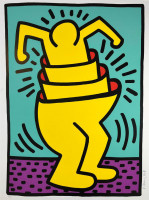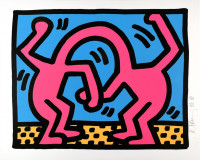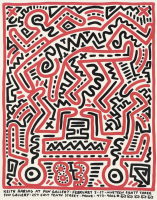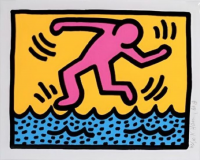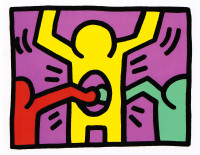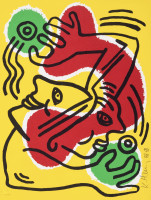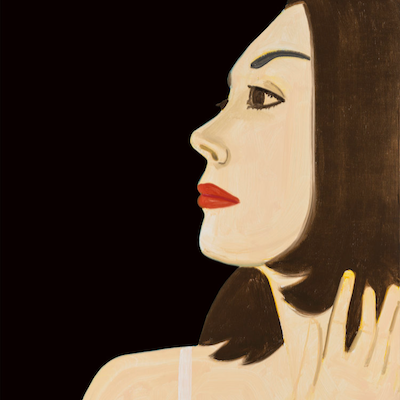



Details
Artist
Styles
By Keith Haring and Toshiyuki Kita - Reverse Printed Glass Mounted on Stone Base - Published by Kreon - Signed in the Plate by Haring and Kita // The Keith Haring Table Lamp (1988) is a mixed media sculpture that brilliantly merges utility with art, designed by the iconic artist Keith Haring in collaboration with Toshiyuki Kita. The lamp, measuring 54 x 31.8 cm, features Haring's distinctive animated figure, reverse-printed on glass, mounted on a sturdy stone base. The figure appears lively and in motion, embodying Haring's dynamic, bold line work and playful aesthetic. The blue background provides a vibrant contrast to the white figure, making the piece visually striking. Published by Kreon and signed in the plate by both Haring and Kita, the lamp reflects Haring's ethos of accessible, everyday art while maintaining his Pop Art and Graffiti roots. The piece serves not only as functional decor but also as a captivating visual statement, perfect for any contemporary art enthusiast.
Keith Haring Table Lamp, 1988
form
Medium
Size
54 x 31.8 cm
- Inches
- Centimeters
Edition
Price
- USD
- EUR
- GBP
Details
Artist
Styles
By Keith Haring and Toshiyuki Kita - Reverse Printed Glass Mounted on Stone Base - Published by Kreon - Signed in the Plate by Haring and Kita // The Keith Haring Table Lamp (1988) is a mixed media sculpture that brilliantly merges utility with art, designed by the iconic artist Keith Haring in collaboration with Toshiyuki Kita. The lamp, measuring 54 x 31.8 cm, features Haring's distinctive animated figure, reverse-printed on glass, mounted on a sturdy stone base. The figure appears lively and in motion, embodying Haring's dynamic, bold line work and playful aesthetic. The blue background provides a vibrant contrast to the white figure, making the piece visually striking. Published by Kreon and signed in the plate by both Haring and Kita, the lamp reflects Haring's ethos of accessible, everyday art while maintaining his Pop Art and Graffiti roots. The piece serves not only as functional decor but also as a captivating visual statement, perfect for any contemporary art enthusiast.
- Recently Added
- Price (low-high )
- Price (high-low )
- Year (low-high )
- Year (high-low )
Keith Haring
Untitled (Plate 16) From The Blueprint Drawings, 1990
Limited Edition Print
Screen-print
USD 35,000 - 45,000
Keith Haring
Untitled (Plate 17) From The Blueprint Drawings, 1990
Limited Edition Print
Screen-print
USD 35,000 - 45,000
Keith Haring
Three Lithographs: One Plate, 1985
Limited Edition Print
Lithograph
USD 30,000 - 40,000
Keith Haring
Poster For Nuclear Disarmament, 1982
Limited Edition Print
Offset Print
Inquire For Price
Keith Haring
Untitled (w/ Sean Kalish) - Set, 1989
Limited Edition Print
Etching
USD 35,000 - 45,000
Keith Haring
New Year's Invitation '88 (Nude) (TP), 1988
Limited Edition Print
Screen-print
USD 8,500
Keith Haring
White Icons (C) - Winged Angel, 1990
Limited Edition Print
Embossing
USD 15,000 - 20,000
Keith Haring
Untitled 1 (from Free South Africa), 1985
Limited Edition Print
Lithograph
Inquire For Price
Keith Haring
Untitled (Free South Africa), 1985
Limited Edition Print
Lithograph
USD 90,000 - 100,000
Keith Haring
White Icons (A) - Radiant Baby, 1990
Limited Edition Print
Embossing
USD 20,000 - 25,000
Keith Haring
Untitled - Scissors (from Pop Shop III), 1989
Limited Edition Print
Screen-print
Currently Not Available
Keith Haring
Untitled (Man On Dolphin), 1987
Limited Edition Print
Lithograph
Currently Not Available
What is figurative art?
Sometimes known as Figurativism, figurative art refers to sculptures and paintings that are clearly or specifically derived from real objects, making them representational. The term figurative art is often used in contrast to abstract art. However, since the emergence of abstract art, figurative art has come to describe any form of modern art that has strong references to the real world or actual situations.



